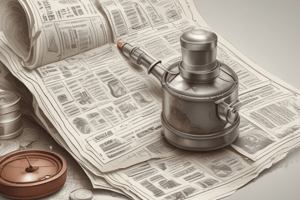Podcast
Questions and Answers
What does the term 'end of life' signify for a product?
What does the term 'end of life' signify for a product?
- The product remains on the price list with limited support.
- The product is no longer supported, developed, or sold. (correct)
- The product is being phased out slowly over a year.
- The product is being frequently updated and improved.
When should considerations for a product's end of life ideally begin?
When should considerations for a product's end of life ideally begin?
- During the product's initial introduction. (correct)
- After significant sales decline is observed.
- When replacement parts are no longer available.
- Once competitors introduce similar products.
What happens to customers using a product that has reached its end of life?
What happens to customers using a product that has reached its end of life?
- They are automatically enrolled in an upgrade program.
- They receive a discount on future purchases.
- They use the product at their own risk with no support available. (correct)
- They are given continuous updates and support.
Which of the following is NOT typically considered when planning for a product's end of life?
Which of the following is NOT typically considered when planning for a product's end of life?
What key factor must be considered when deciding to end the life of a product?
What key factor must be considered when deciding to end the life of a product?
What balance must companies achieve when deciding to end the life of a product?
What balance must companies achieve when deciding to end the life of a product?
Which aspect is NOT a consideration when retiring a product?
Which aspect is NOT a consideration when retiring a product?
What might a company do after determining a product's end of life?
What might a company do after determining a product's end of life?
Study Notes
End of Life of a Product
- End of Life (EOL) marks the point when a product is no longer developed, supported, or sold.
- EOL status means no replacement parts, integrations, or support are available for users.
- Preparation for EOL should begin during the product introduction phase, considering the future retirement strategy.
Timing Considerations for EOL
- The decision on when to retire a product depends on market status, industry health, and the product's profitability.
- Companies need to assess their market position and potential threats from new offerings.
Examples of EOL Management
- Hewlett Packard demonstrates effective EOL management by discontinuing older printer models and their associated supplies.
- Understanding customer needs while balancing company goals is crucial during the EOL transition.
Communication and Collaboration
- Ending a product often requires complex communication across departments to ensure alignment with both customer and company goals.
- Departments to consider for communication include marketing, sales, customer service, and support.
Implementing the Productside Blueprint
- The Productside Blueprint can guide the process of product retirement, ensuring structured evaluation and implementation steps.
- Activities during EOL process include assessing the impact on customers, determining the timeline, and executing a communication plan.
Studying That Suits You
Use AI to generate personalized quizzes and flashcards to suit your learning preferences.
Description
This quiz covers the concepts of product retirement and End of Life processes. You will learn how to apply the Productside Blueprint to effectively decide when to retire a product. This lesson emphasizes practical application and the strategic importance of managing a product's lifecycle.




